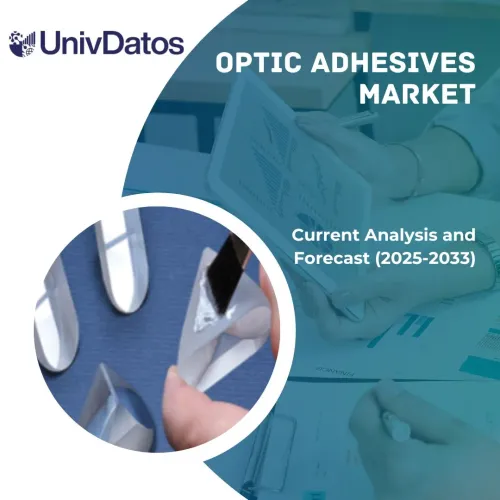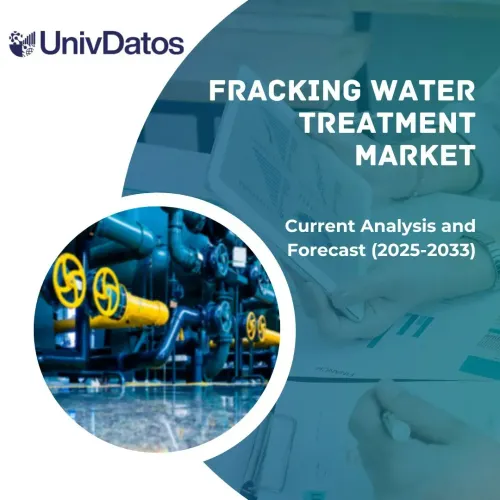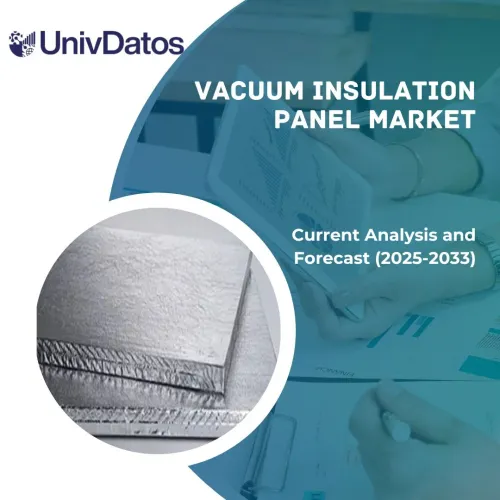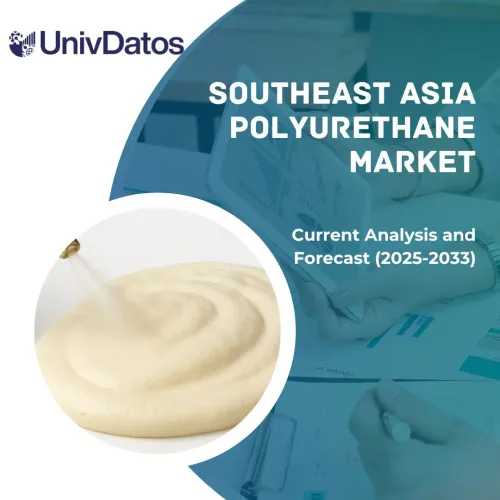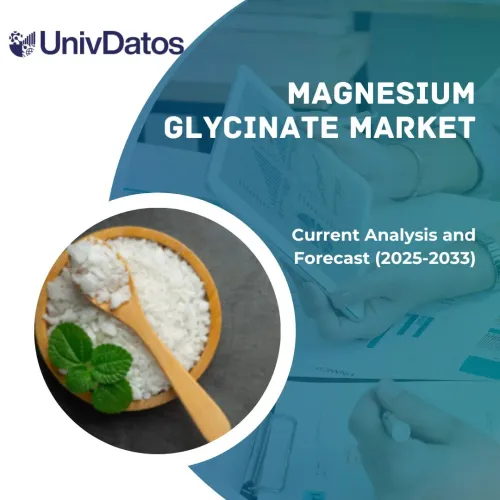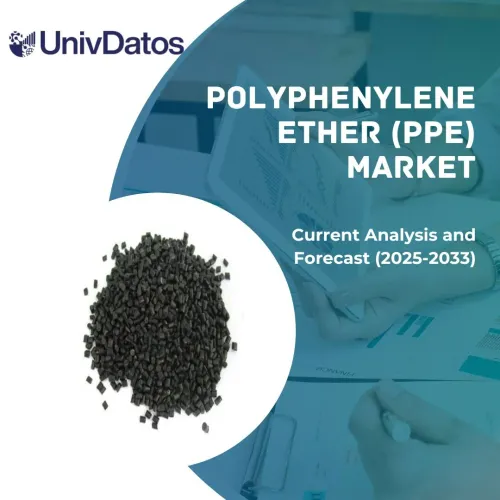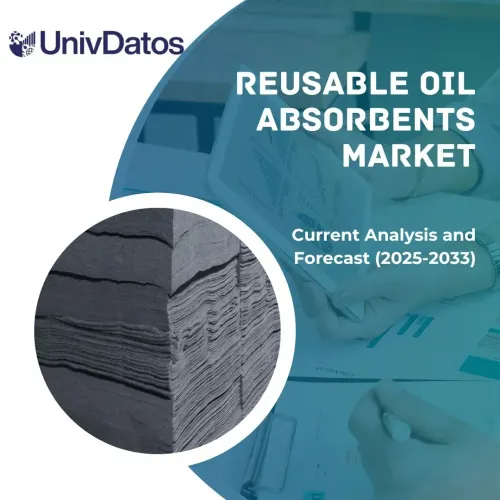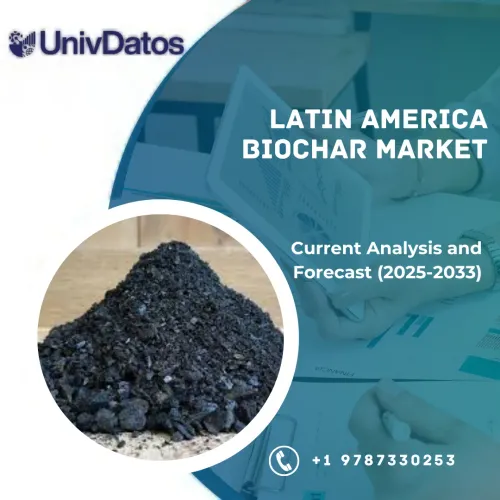- Home
- About Us
- Industry
- Services
- Reading
- Contact Us
Redispersible Polymer Powder Market: Current Analysis and Forecast (2025-2033)
Emphasis On Polymer Type (Vinyl Ester of Versatic Acid, Vinyl Acetate Ethylene, Styrene Butadiene, and Others), By Application (Mortar & Cement, Insulation and Finish Systems, Tile Adhesive & Grout, Self-Leveling Underlayment, Plaster, and Others), By End-Use (Residential, and Non-Residential) Region/Country
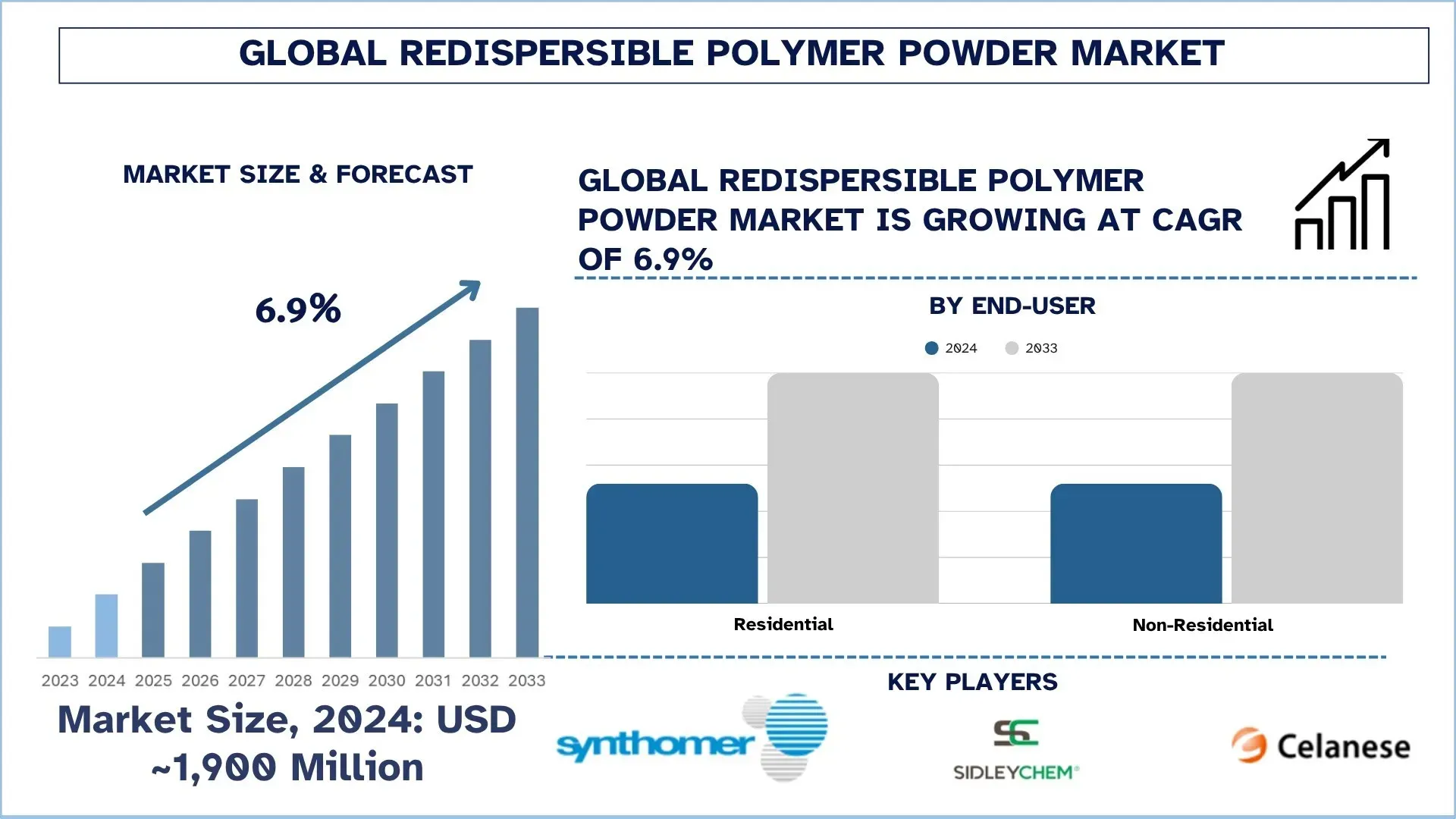
Global Redispersible Polymer Powder Market Size & Forecast
The Global Redispersible Polymer Powder Market was valued at USD 1,900 million in 2024 and is expected to grow to a strong CAGR of around 6.9% during the forecast period (2025-2033F), owing to the rising construction and renovation activities.
Redispersible Polymer Powder Market Analysis
The global redispersible polymer powder (RPP) market is exhibiting a fast growth due to factors such as rapid urbanization, rising infrastructure development, and increasing demand for inexpensive yet high-quality construction materials. Considering its ability to enhance adhesion, flexibility, and water resistance, RPP is a very important ingredient construction application such as in dry-mix mortars, tile adhesives, repair compounds, and insulation systems. In return, the rising awareness toward green building and energy-efficient materials in the construction landscape has favored RPP usage. Furthermore, increased consideration and preference for prefabrication and modular construction will also escalate demand for modern formulations of dry-mix materials enhanced by RPP. With the emergence of sustainable infrastructure promoted by governments and intense competition for speed and quality on the private side, RPP is now being recognized as one of the key components in modern construction chemistry.
Global Redispersible Polymer Powder Market Trends
This section discusses the key market trends that are influencing the various segments of the global Redispersible Polymer Powder market, as found by our team of research experts.
Bio‑based & sustainable RPP formulations:
One of the trends experiencing growth in RPP is in bio-based and sustainable formulations. As environmental regulations stiffen and green building certifications gain more momentum, manufacturers find ever-increasing pressure to make their products with a smaller carbon footprint or environmental impact. Then again, a conventional RPP would usually be petroleum-derived, but now polymer chemistry opens the possibility of using renewable raw materials such as bio-based polyvinyl alcohol or natural polymers. Production-wise, these substitutes result in fewer emissions while presenting comparable mechanical properties. Consumers who are conscious about sustainability, especially across Europe and North America, are directing the demand toward eco-friendly building materials. Large construction companies are joining in, and government projects tend to give some preference to suppliers with green offerings. With bio-based RPPs still somewhat blossoming in the market, they're soon projected to carve their way into a stronger market position as the technology improves and awareness grows, all within the framework of working toward global objectives for energy efficiency and low-impact construction methods.
Redispersible Polymer Powder Industry Segmentation:
This section provides an analysis of the key trends in each segment of the global Redispersible Polymer Powder market report, along with forecasts at the global, regional, and country levels for 2025-2033.
The Vinyl Acetate Ethylene Category has shown promising growth in the Redispersible Polymer Powder Market.
Based on polymer type, the market is segmented into vinyl ester of versatic acid, vinyl acetate ethylene, styrene butadiene, and others. Among these, vinyl acetate ethylene has enjoyed a large market share owing to a good blend of flexibility, adhesion, and water resistance properties, making it very useful in tile adhesives, wall putty, as well as cement-based mortar. VAE can also be favored due to its compatibility with other substrates as well as the ease of evaluation in dry-mix formulations. The fact that it has a relatively small amount of environmental effect, thermal stability, and affordability also boosts its popularity, especially in the developing part of the world, where the rate of construction is evident in large quantities.
Tile Adhesive & Grout Category Dominates the Redispersible Polymer Powder Market.
On the application basis, the market has been divided into mortar & cement, insulation and finish systems, tile adhesive & grout, self-leveling underlayment, plaster, and others. Among them, tile adhesives & grouts have demonstrated incredible performance since ceramic tiles have increased in demand in residential and commercial constructions. Because redispersible polymer powder has superior bonding strength, flexibility, and water resistance, it is needed as an addition in these applications. Also, the rising renovation works and growing tendency to develop beautiful interior design are the other factors contributing to high-performance adhesives and grouts consumption in the emerging countries.
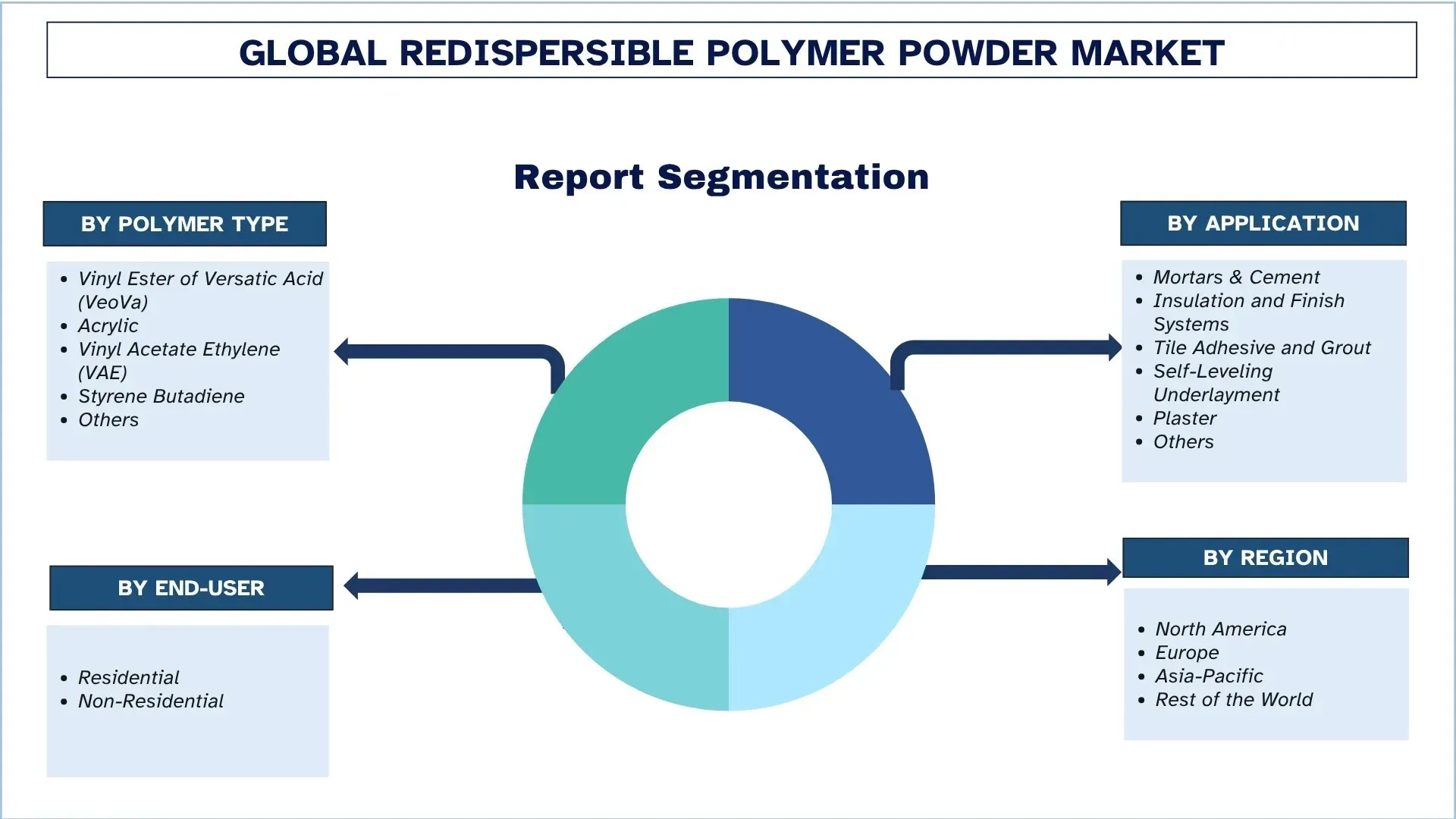
Asia-Pacific is expected to grow at a considerable rate during the forecast period.
Asia-Pacific is the fastest-growing market for the RPP, driven by accelerated urbanization, heavy infrastructure development, and the construction boom. China, India, Indonesia, and Vietnam are currently witnessing large-scale residential projects, commercial projects, and public infrastructure projects, all supported by government initiatives for affordable housing and smart city development. RPP is used in making tile adhesives, skim coat, wall putty, and cementitious waterproofing, and thus has remained synonymous with modern construction practice in the region.
The Chinese market remains the largest, owing to the scale of construction and extensive use of dry-mix mortars. Meanwhile, India is soon to catch up, owing to schemes like “Housing for All” and “Make in India,” which promote construction and local manufacture of building materials. Apart from that, green construction and energy-efficient buildings are being kept in mind while material selection, thus opening doors for the greener RPP formulations. There is also an increased demand for high-performance construction chemicals in the Asia-Pacific region, which would assist market growth in the coming years.
China is expected to grow at a considerable rate during the forecast period.
China is by far the largest in the world market of redispersible polymer powder (RPP) because of its enormous construction industry and its high use of the dry-mix mortar technology. Urban redevelopment, infrastructure improvements, and sustainable housing represent the core priority of the country, which keeps on driving the demand for high-performance building materials such as RPP. Green construction and environmental guidelines offered by the government and increased environmental regulations are also encouraging energy-efficient, lower VOC materials. Moreover, increased use of RPP is being contributed to by the drive towards pre-fabrication and modular building structures, which aim at industrializing the construction process. Both domestic and foreign companies are increasing production to serve the demands and changing quality requirements of China.
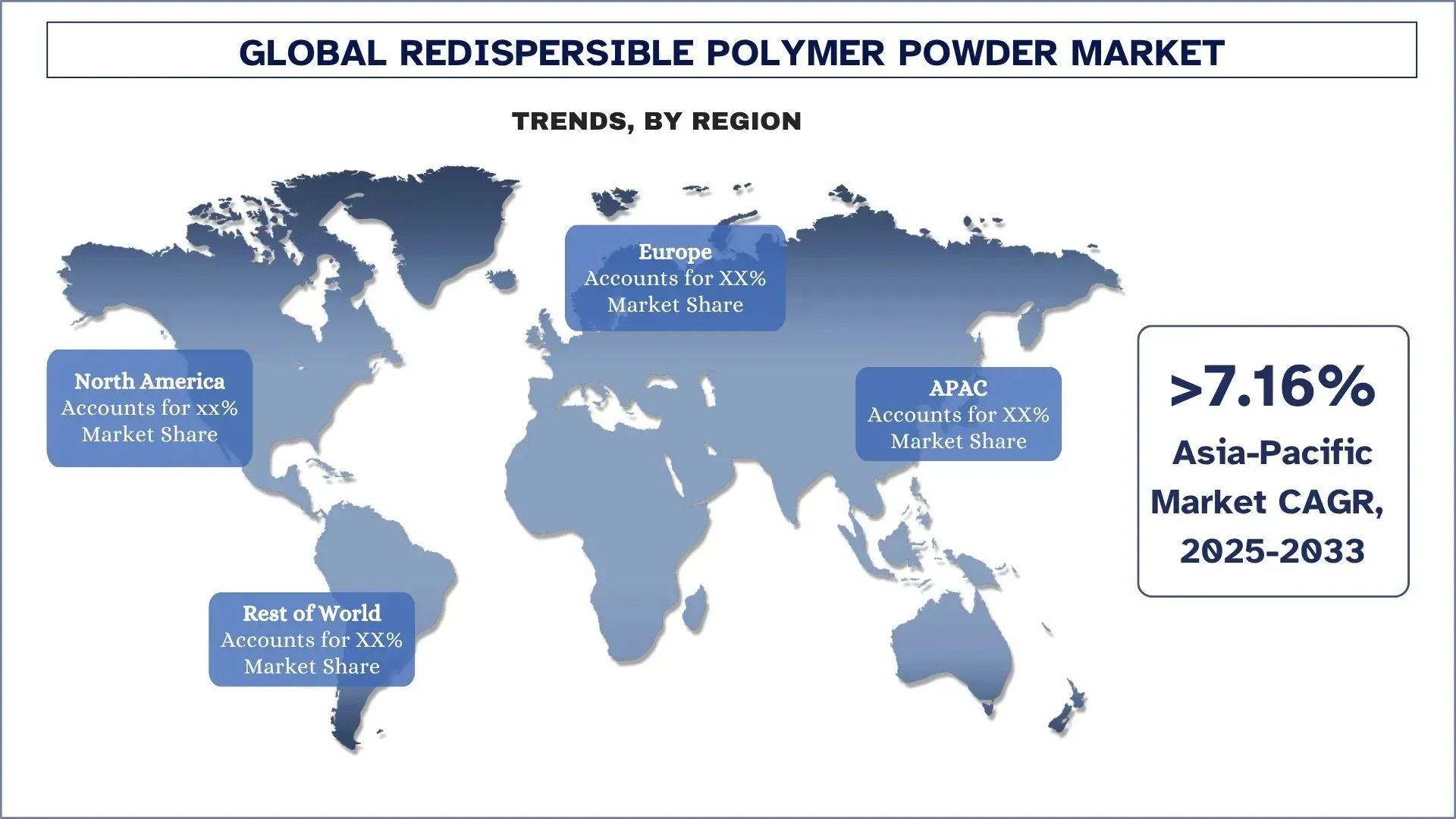
Redispersible Polymer Powder Industry Competitive Landscape:
The global Redispersible Polymer Powder market is competitive, with several global and international market players. The key players are adopting different growth strategies to enhance their market presence, such as partnerships, agreements, collaborations, new product launches, geographical expansions, and mergers and acquisitions.
Top Redispersible Polymer Powder Companies
Some of the major players in the market are Synthomer plc, Dow Chemical Company, SIDLEY CHEMICAL CO., LTD., Celanese Corporation, LANDU, Dongxing Chemical, Shandong Kundu Chemical Co., Ltd., Wacker Chemical AG, Celotech Chemical Co., Ltd., and Auro Chemical.
Recent Developments in the Redispersible Polymer Powder Market
In 2025, Wacker Chemical AG announced the expansion of its redispersible polymer powder plant in South Korea and Japan. According to the company, it will serve the growing demand from the automotive and construction industries for these products. In total, WACKER has invested an amount in the double-digit million Euro range in capacity expansions.
Global Redispersible Polymer Powder Market Report Coverage
Details | |
Base year | 2024 |
Forecast period | 2025-2033 |
Growth momentum | Accelerate at a CAGR of 6.9% |
Market size 2024 | USD 1,900 Million |
Regional analysis | North America, Europe, APAC, Rest of the World |
Major contributing region | Asia-Pacific is expected to dominate the market during the forecast period. |
Key countries covered | U.S., Canada, Germany, U.K., Spain, Italy, France, China, Japan, South Korea, and India |
Companies profiled | Synthomer plc, Dow Chemical Company, SIDLEY CHEMICAL CO., LTD., Celanese Corporation, LANDU, Dongxing Chemical, Shandong Kundu Chemical Co., Ltd., Wacker Chemical AG, Celotech Chemical Co., Ltd., and Auro Chemical. |
Report Scope | Market Trends, Drivers, and Restraints; Revenue Estimation and Forecast; Segmentation Analysis; Demand and Supply Side Analysis; Competitive Landscape; Company Profiling |
Segments Covered | By Polymer Type, By Application, By End-User, by Region/Country |
Reasons to Buy the Redispersible Polymer Powder Market Report:
The study includes market sizing and forecasting analysis confirmed by authenticated key industry experts.
The report briefly reviews overall industry performance at a glance.
The report covers an in-depth analysis of prominent industry peers, primarily focusing on key business financials, type portfolios, expansion strategies, and recent developments.
Detailed examination of drivers, restraints, key trends, and opportunities prevailing in the industry.
The study comprehensively covers the market across different segments.
Deep dive regional-level analysis of the industry.
Customization Options:
The global Redispersible Polymer Powder market can further be customized as per the requirements or any other market segment. Besides this, UnivDatos understands that you may have your own business needs; hence, feel free to contact us to get a report that completely suits your requirements.
Table of Content
Research Methodology for the Global Redispersible Polymer Powder Market Analysis (2023-2033)
We analyzed the historical market, estimated the current market, and forecasted the future market of the global Redispersible Polymer Powder market to assess its application in major regions worldwide. We conducted exhaustive secondary research to gather historical market data and estimate the current market size. To validate these insights, we carefully reviewed numerous findings and assumptions. Additionally, we conducted in-depth primary interviews with industry experts across the Redispersible Polymer Powder value chain. After validating market figures through these interviews, we used both top-down and bottom-up approaches to forecast the overall market size. We then employed market breakdown and data triangulation methods to estimate and analyze the market size of industry segments and sub-segments.
Market Engineering
We employed the data triangulation technique to finalize the overall market estimation and derive precise statistical numbers for each segment and sub-segment of the global Redispersible Polymer Powder market. We split the data into several segments and sub-segments by analyzing various parameters and trends, by Polymer Type, by Application, by End-User, and by regions within the global Redispersible Polymer Powder market.
The Main Objective of the Global Redispersible Polymer Powder Market Study
The study identifies current and future trends in the global Redispersible Polymer Powder market, providing strategic insights for investors. It highlights regional market attractiveness, enabling industry participants to tap into untapped markets and gain a first-mover advantage. Other quantitative goals of the studies include:
Market Size Analysis: Assess the current forecast and market size of the global Redispersible Polymer Powder market and its segments in terms of value (USD).
Redispersible Polymer Powder Market Segmentation: Segments in the study include areas By Polymer Type, By Application, By End-User, and by
Regulatory Framework & Value Chain Analysis: Examine the regulatory framework, value chain, customer behavior, and competitive landscape of the Redispersible Polymer Powder industry.
Regional Analysis: Conduct a detailed regional analysis for key areas such as Asia Pacific, Europe, North America, and the Rest of the World.
Company Profiles & Growth Strategies: Company profiles of the Redispersible Polymer Powder market and the growth strategies adopted by the market players to sustain the fast-growing market.
Frequently Asked Questions FAQs
Q1: What is the global Redispersible Polymer Powder market’s current market size and growth potential?
The global Redispersible Polymer Powder market was valued at USD 1,900 Million in 2024 and is expected to grow at a CAGR of 6.9% during the forecast period (2025-2033).
Q2: Which segment has the largest share of the global Redispersible Polymer Powder market by Polymer Type?
Vinyl acetate ethylene has enjoyed a large market share owing to a good blend of flexibility, adhesion, and water resistance properties, making it very useful in tile adhesives, wall putty, as well as cement-based mortar.
Q3: What are the driving factors for the growth of the global Redispersible Polymer Powder market?
• Shift Toward Sustainable, Green Building Materials: Rising environmental regulations and eco-conscious construction practices are boosting demand for low-VOC, bio-based redispersible polymer powder formulations.
• Technological Production Advances: Innovations in polymer chemistry and spray-drying technology are enhancing RPP quality, efficiency, and scalability to meet growing global construction demands.
Q4: What are the emerging technologies and trends in the global Redispersible Polymer Powder market?
• Bio-Based & Sustainable RPP Formulations: Increasing focus on eco-friendly construction is driving demand for RPP derived from renewable sources like bio-based polymers and natural additives.
• Diversification into Non-Construction Sectors: RPP is expanding into industries like paints, coatings, textiles, and automotive, leveraging its versatile performance and broadening market potential beyond construction.
Q5: What are the key challenges in the global Redispersible Polymer Powder market?
• Volatility in Raw Material Prices: Fluctuating costs of petrochemical-derived inputs affect production stability and profit margins for RPP manufacturers across global markets.
• Regulatory Compliance and Environmental Standards: Meeting diverse and evolving regional regulations, especially related to VOC content and chemical safety, poses operational and compliance challenges for producers.
Q6: Which region dominates the global Redispersible Polymer Powder market?
The Asia-Pacific region dominates the global Redispersible Polymer Powder market due to the rising demand for construction and renovation activities.
Q7: Who are the key players in the global Redispersible Polymer Powder market?
Some of the top Redispersible Polymer Powder companies include:
• Synthomer plc
• Dow Chemical Company
• SIDLEY CHEMICAL CO., LTD.
• Celanese Corporation,
• LANDU
• Dongxing Chemical
• Shandong Kundu Chemical Co., Ltd.
• Wacker Chemical AG
• Celotech Chemical Co., Ltd.
• Auro Chemical
Q8: What is the key opportunity for companies within the Global Redispersible Polymer Powder market?
The rising adoption of modular and prefabricated construction methods presents a significant opportunity for the redispersible polymer powder (RPP) market. These construction techniques require high-performance, easy-to-handle dry-mix materials, where RPP plays a critical role in enhancing workability, adhesion, and curing speed. As urban centers expand and labor costs rise, modular construction offers a faster, more cost-efficient alternative to traditional methods. Governments and developers are increasingly turning to this approach for housing and infrastructure projects, especially in Asia-Pacific and North America, creating a steady demand for RPP in factory-produced building systems and pre-blended mortars.
Q9: What role does government housing policy play in RPP market growth?
Government-backed affordable housing schemes, especially in countries like India, China, and Indonesia, are significantly boosting RPP demand. These initiatives require durable, cost-efficient construction materials, making RPP ideal for large-scale use in tile adhesives, wall putty, and plasters within fast-paced residential development projects.
Related Reports
Customers who bought this item also bought

